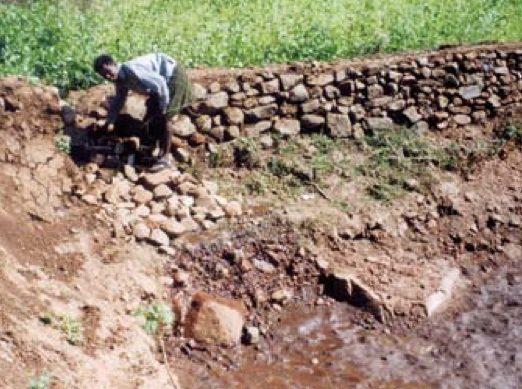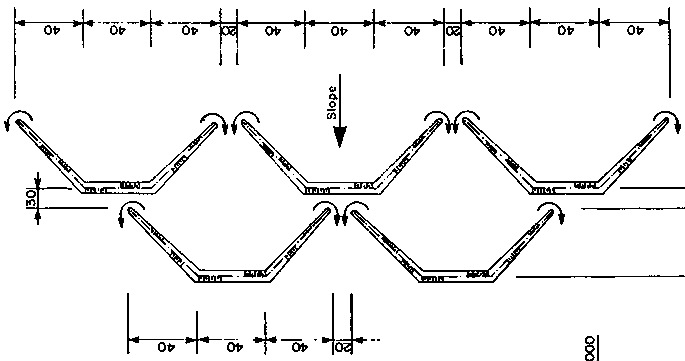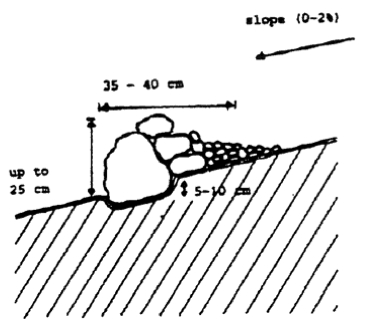Difference between revisions of "वाटर पोर्टल / वर्षाजल संचयन / भूजल पुनर्भरण / पुस्ता या खेत-बन्धी"
| Line 11: | Line 11: | ||
पश्चिम अफ्रीका में प्रौद्योगिकी का व्यापक रूप से घाटी के निचले हिस्से में प्रयोग किया जाता है. | पश्चिम अफ्रीका में प्रौद्योगिकी का व्यापक रूप से घाटी के निचले हिस्से में प्रयोग किया जाता है. | ||
| − | === | + | ===किन परिस्थितियों में यह काम करता है=== |
| − | * | + | * प्राकृतिक अपवाह क्षेत्रों में खेत-बन्धियों का पता लगाएँ, खास तौर पर ऐसी स्थलाकृति जो पहले से इस आकार में हों- संकेतकों में यह भी देखना चाहिये कि पानी बाढ़ के दौरान किधर से बहती है, और मिट्टी/वनस्पति की प्रकार. कुंजी यह है कि प्रत्येक साइट को व्यक्तिगत रूप से देखें और प्राकृतिक स्थलाकृतिक की सुविधाओं के साथ काम करें- क्षेत्र के अनुभव के संरचना को दिशा देना चाहिये. |
| − | * | + | * निम्नलिखित चीजों से बचें: |
| − | 1. | + | 1. मृदा क्षेत्र - उच्च मृदा सामग्री से बना पुस्ता या खेत-बन्धी पाइप से लीक करने लगता है, क्योंकि सूखने से पुस्ता या खेत-बन्धी में दरारें पड़ जाती हैं. <br> |
| − | 2. | + | 2. वृहद जल धाराओं की निकटता. <br> |
| − | 3. | + | 3. साइट पर व्यापक लेवलिंग की आवश्यकता.<br> |
| − | * | + | * आसपास की मिट्टी में पर्याप्त जल रिसाव क्षमता होनी चाहिये. |
| − | * | + | * आदर्श रूप में ढाल 1.5% से अधिक नहीं हो अन्यथा ज़मीनी काम नहीं हो पाता है. |
| − | * | + | * कृत्रिम हिमनद के लिए, ऊंचाई 4,600 मीटर से अधिक होनी चाहिये. |
| − | * | + | * तलहटी क्षेत्रों में उच्च तीव्रता और के साथ कम अवधि वर्षा होनी चाहिये, सालाना वर्षा 50 से 400 मिमी के के बीच होनी चाहिये. |
| − | * | + | * जलग्रहण आम तौर पर खेती के जमीन की (अर्ध शुष्क) 2-3 गुनी होनी चाहिये. |
| Line 43: | Line 43: | ||
- Popularity of the stone type of bund can result in shortages of stones, resulting in a higher cost for latecomers. <br> | - Popularity of the stone type of bund can result in shortages of stones, resulting in a higher cost for latecomers. <br> | ||
|} | |} | ||
| − | |||
===Resilience to changes in the environment=== | ===Resilience to changes in the environment=== | ||
Revision as of 09:27, 3 December 2015
| |
|
|
|
|
|
|
|
|

पुस्ता या खेत-बन्धी (जिन्हें टेरेस भी कहा जाता है) बाहरी जलग्रहण से आने वाली अपवाह के लिए एक छोटा अवरोध होती हैं (और संभवतः उस खेत के पास जहां फसलें उगाई जाती हैं). पुस्ता या खेत-बन्धी जमीन की सतह पर पानी के प्रवाह को धीमा करती हैं और भूजल पुनर्भरण तथा मिट्टी की नमी लाने को प्रोत्साहित करती हैं. खेत-बन्धियों के विभिन्न प्रकार के होते हैं. एक आयताकार प्रकार, जहां जमीन तीन तरफ से "घिरी" हो, चौथा किनारा बारिश के जल को ग्रहण करने के लिए खोल रखा गया हो, किसी ऊंचे इलाके से और समोच्च प्रकार से, जहां पुस्ता या खेत-बन्धी एक ढाल के समोच्च साथ पंक्तियों में बनाए गए हों. पुस्ता या खेत-बन्धी छोटे पत्थर या मिट्टी की दीवारों से बनता है. पुस्ता या खेत-बन्धी के अंदर एक छोटी सी नहर को बनाया जाता है, पानी के साथ-साथ चलने के लिए. बाहरी बाहों (आयताकार प्रकार) के शिखर के साथ अतिरिक्त पानी बह जाती है. ये स्लिपवेज दक्षता में सुधार और टेराज के रखरखाव की लागत को कम कर सकते हैं. ये बाहें आमतौर पर 20-100 मीटर लंबी होती हैं, जबकि आधार खेत-बन्धी, 50-300 मीटर लंबा हो सकता है. पुस्ता या खेत-बन्धी केवल पानी को निकालने के लिए नहीं बनाये जाते, बल्कि मिट्टी की नमी बढ़ाने और भूजल पुनर्भरण में योगदान देने के लिए भी.
पुस्ता या खेत-बन्धी डिजाइन स्थानीय परिस्थितियों के अनुसार समायोजित किया जाना चाहिये. वे डिजाइन में भिन्न हो सकते है और गैर संलग्न सिस्टम को शामिल कर सकते हैं (जैसे, समलम्बाकार पुस्ता या खेत-बन्धी से पानी किनारों के पास से निकल जाता है), और संलग्न सिस्टम को भी ( जैसे, खेत-बन्धी हुई जमीन जहां से पानी एक चैनल के माध्यम से प्रवेश करती है और एक स्पिलवे से पलायन, जब बाढ़ आता है). निश्चित साइट-विशिष्ट उदाहरणों में, वे छोटे कृत्रिम हिमनद बनाने में मदद करते हैं, वहां से पानी धीमी रफ्तार में रिसता रहता है ताकि कम बुवाई के मौसम को समायोजित किया जा सके.
पश्चिम अफ्रीका में प्रौद्योगिकी का व्यापक रूप से घाटी के निचले हिस्से में प्रयोग किया जाता है.
किन परिस्थितियों में यह काम करता है
- प्राकृतिक अपवाह क्षेत्रों में खेत-बन्धियों का पता लगाएँ, खास तौर पर ऐसी स्थलाकृति जो पहले से इस आकार में हों- संकेतकों में यह भी देखना चाहिये कि पानी बाढ़ के दौरान किधर से बहती है, और मिट्टी/वनस्पति की प्रकार. कुंजी यह है कि प्रत्येक साइट को व्यक्तिगत रूप से देखें और प्राकृतिक स्थलाकृतिक की सुविधाओं के साथ काम करें- क्षेत्र के अनुभव के संरचना को दिशा देना चाहिये.
- निम्नलिखित चीजों से बचें:
1. मृदा क्षेत्र - उच्च मृदा सामग्री से बना पुस्ता या खेत-बन्धी पाइप से लीक करने लगता है, क्योंकि सूखने से पुस्ता या खेत-बन्धी में दरारें पड़ जाती हैं.
2. वृहद जल धाराओं की निकटता.
3. साइट पर व्यापक लेवलिंग की आवश्यकता.
- आसपास की मिट्टी में पर्याप्त जल रिसाव क्षमता होनी चाहिये.
- आदर्श रूप में ढाल 1.5% से अधिक नहीं हो अन्यथा ज़मीनी काम नहीं हो पाता है.
- कृत्रिम हिमनद के लिए, ऊंचाई 4,600 मीटर से अधिक होनी चाहिये.
- तलहटी क्षेत्रों में उच्च तीव्रता और के साथ कम अवधि वर्षा होनी चाहिये, सालाना वर्षा 50 से 400 मिमी के के बीच होनी चाहिये.
- जलग्रहण आम तौर पर खेती के जमीन की (अर्ध शुष्क) 2-3 गुनी होनी चाहिये.
| Advantages | Disadvantages |
|---|---|
| - Can assist recharge of shallow wells - Can reduce salinity in groundwater |
- High cost and effort involved in some earthworks, so poor or vulnerable families (e.g. single headed households) may struggle. A possible remedy: reduce donor dependency... use grain from harvests to pay off a loan that was used for the earthworks. Artificial glaciers in India were costing around $6,000 but it depends on the site. - Breached bunds will require repair work |
Resilience to changes in the environment
Drought
Effects of drought: Lower crop yields.
Underlying causes of effects: Less water to crops from flooding.
To increase resiliency of WASH system: Drought-resistant & fast-growing crops; Diversify livelihoods of farmers.
More information on managing drought: Resilient WASH systems in drought-prone areas.
Floods
When a region with bunds floods, strengthen the existing bunds by raising them several feet, otherwise breaches are possible. This is especially important when bunds are used to protect crops or urban/residential areas.
Construction, operations and maintenance
Local people should have a good degree of control in programme implementation, and the focus should be on appropriate techniques that can be operated and maintained using local resources. However, social/institutional constraints are not the only (or even primary) concern when building bunds – technical considerations are often overlooked. A few lessons learned are listed here which might apply generally:
- The erratic nature of rainfall intensity and lack of good rainfall data meant that designing bunds based on certain assumed runoff coefficients was difficult - sometimes runoff was vastly underestimated, and this was the reason for 90% failure rate of earthworks during the first 2 years of a large bund building programme where high runoff flows damaged bunds. Stone bunds (if stones are available) would work better.
- Undamaged bunds were related to catchment size – smaller catchments that were 4-5 times the size of the cultivated area were not damaged, whereas larger catchments caused bunds to be overtopped due to under-designed spillways. Smaller and more numerous catchments were therefore deemed to be preferable due to the reduced risk associated with them.
- Bund height will vary from site to site, and is related to the slope of land and area to be inundated. The challenge is to size the field/bund area to ensure retention of enough water to carry a crop to maturity from one single flood, without making it susceptible to large unexpected runoff flows – e.g. in Turkana, designing bunds to allow 30cm of flood depth (as confirmed by local knowledge) or in India it meant a flood depth of 15cm.
- Trapezoidal bunds work well in high rainfall intensity areas, and spillways around the edge worked better than spillways in the centre of the bund where erosional forces were concentrated. Even stone-faced spillways (as per Israeli design) were not always robust. Therefore type of bund has to be applicable to the local conditions. The exact shape of the trapezoidal bund varies in shape according to the terrain.
- A few tips for construction of trapezoidal bunds: leveling the cultivated area within a bunded area is a good thing to do since it spreads flood depth evenly; a cut-off drain uphill of the bund allows high flows to be diverted if necessary, protecting the bund; trapezoidal bunds should be reinforced with stonework to counter erosive forces as this is the edge of the spillway in these bunds; low-tech leveling devices help uneducated people to be trained in designing their own bunds.
- Bunds should be adequately compacted. If animals are used to create the bunds, they can help to compact the soil with their hooves. It also seems best to make bunds in the middle of the dry season so that they can settle under impact of human and livestock movement, in order to make them sturdy enough for the rainy season. Access to finance therefore seems to be important in allowing farmers to implement bunds. Due to the uncertain nature of flood events, it is important to plant drought-resistant (local) crop varieties in the fields which give better results.
- In the site-specific case of artificial glaciers, the following methods are used: before the onset of winter, water is channelled from existing streams through 1.5” GI pipes into shadow areas of mountains close to villages. The water is made to flow out onto a sloping hill face where at regular intervals along the mountain slope, small stone embankments are situated to impede the flow of water which helps to create shallow pools. These pools freeze rather than infiltrate, but water is later released for crop irrigation prior to the usual time when snow melts on mountain tops. In this way, water is available more reliably for crops during a very short sowing season.
Maintenance
Stone bunds: There is limited, ongoing repair required as the stones are not vulnerable to erosion. However, silting behind the stone bunds requires that the stones to be relaid from time to time. Care must be taken that overtopping of the bunds does not lead to erosion on the downstream face, with subsequent gully formation and undercutting of the bund.
Costs
- Where stones are in short supply, there are increased costs associated with their acquisition and transport.
- Labour for construction: 6-16 days per hectare. Annual maintenance: 3-18 days per hectare.
- If bunds are formed in a terrace-like design, the labour required for construction is estimated at 150 to 350 person days/ha for terraces and cut off drains. The cost of these structures is approximately $60-460/ha.
Manuals, videos, and links
- Sourcebook of Alternative Technologies for Freshwater Augumentation in Africa or (alternative link). United Nations Environment Programme (UNEP), Division of Technology, Industry and Economics.
- Water Harvesting: A Manual for the Design and Construction of Water Harvesting Schemes for Plant Production, FAO, Rome, 1991.
- ARTICLE: Pre-flood warnings: Four bunds could develop breaches. July 9, 2011. The Express Tribune, Pakistan.
- Large wiki on water use for agriculture: Agropedia
Acknowledgements
- CARE Nederland, Desk Study: Resilient WASH systems in drought-prone areas. October, 2010.
- Smart Water Harvesting Solutions: Examples of innovative, low cost technologies for rain, fog, and runoff water and groundwater. (or alternative link) Netherlands Water Partnership, Aqua for All, Agromisa, et al., 2007.
- Rufino, L., Water Conservation Technical Briefs: TB 2 – Rainwater Harvesting and Artificial Recharge to Groundwater. Sustainable Agriculture Initiative (SAI). August, 2009.



